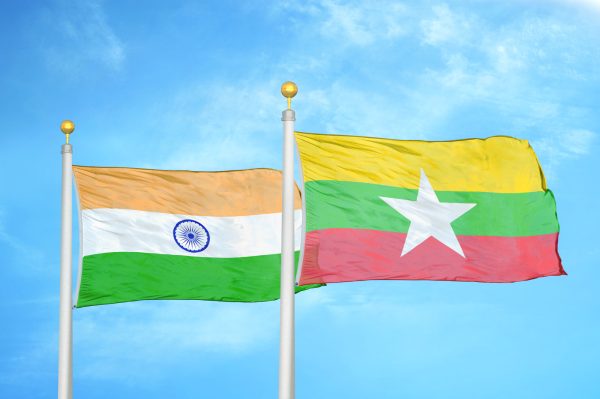
The military coup in Myanmar in February 2021 has altered India’s engagements with the Southeast Asian nation. Myanmar has been an integral part of India’s Act East Policy, with India developing connectivity projects like the India-Myanmar-Thailand Trilateral Highway and the Kaladan Multi-Modal Transit Transport Project linking India’s Northeast region to Southeast Asia. India has thus moved cautiously with regard to Myanmar since the coup, avoiding a confrontational approach with the military government.
This is unlike the Western countries, which have targeted Myanmar’s government as well as its individual officials with sanctions. The United States, the United Kingdom, the European Union, Australia, and Canada have imposed multiple rounds of sanctions on Myanmar. These punitive measures have pushed Myanmar’s military rulers into China’s tight embrace.
While closely engaging in diverse economic and strategic areas, India and the Western countries are positioned on opposite ends of the spectrum on the issue of Myanmar. Geographical proximity has also conditioned India’s response toward Myanmar.
Instability in Myanmar is posing a two-front challenge for India. First, Myanmar is getting closer to China. Second, events in Myanmar are having repercussions in India’s Northeast region.
Myanmar’s isolation has facilitated China to strengthen its presence in India’s neighborhood. China is a major partner of Myanmar, both economically and strategically. China is one of Myanmar’s largest trading partners. The trade volume between the two countries for the year 2022-2023 (up to February) was around $8.4 billion, according to Myanmar’s Ministry of Commerce.
China has also been a major source of investment for Myanmar for decades. Between 1988 and 2019, Chinese investments in Myanmar amounted to more than $25 billion. In the last two years, since the February 2021 coup, China has invested more than $113 million in Myanmar.
The China-Myanmar Economic Corridor under the Belt and Road Initiative (BRI) remains China’s strategically most important investment in Myanmar. This project includes rail and road links as well as gas and oil pipelines. China is developing a deep-sea port at Kyaukphyu on Myanmar’s west coast, which is considered as China’s back door to the Indian Ocean.
China’s increasing footprint in Myanmar is a strategic challenge to India’s engagements with Myanmar as well as to its outreach to Southeast Asia. India’s threat perception is further exacerbated with the reports of China building a listening post on Myanmar’s Great Coco Island, which is just 55 km to the north of India’s Andaman and Nicobar Islands.
This listening post could be used for surveillance and spying in the Indian Ocean and particularly to monitor India’s activities such as naval communication and movements, satellite launches, and missile testing in the region thereby challenging India’s security. China already has a history of creating militarized artificial islands in the South China Sea. Beijing has also been pursuing development of dual-use ports such as Hambantota in Sri Lanka, Gwadar in Pakistan, and also ports in Cambodia and Djibouti.
In recent times, friction between India and China has increased in the Indian Ocean, with Chinese spy ships Yuan Wang 5 and Yuan Wang 6 appearing in the proximity of India’s territorial waters last year.
With strategic interests of both India and China colliding in the Indian Ocean, Myanmar is becoming a launch pad for China in the region, thereby presenting a challenge for India’s security as well as freedom of navigation in Southeast Asia.
On land, India’s Northeast region acts as one of the vital links in connecting India to Southeast Asia. Yet the region had long remained underdeveloped owing to insurgency and had remained mostly disconnected from the rest of India.
Prime Minister Narendra Modi prioritized the development in the northeastern states as a means to bring the region at par with the rest of the country. Infrastructure development is also imperative since the Northeast shares borders with China, Myanmar, Bangladesh, Bhutan, and Nepal. Since 2014-15, India has spent around $50 billion on infrastructure development in the Northeast, which includes road connectivity, air connectivity, railways, waterways, telecom and power.
Along with the infrastructure development the Modi government has also concluded peace accords with several insurgent groups of Northeast, which include the Bodo Accord, the Bru-Reang Agreement, and the Karbi Anglong Agreement. The insurgency in the Northeast has also reduced in the past few years.
However, the situation in Myanmar raises concerns about peace and stability in the Northeast region.
Ethnic groups in the Northeast share kinship ties across the border in Myanmar. Since the military coup, the influx of refugees in the Northeast has complicated inter-community dynamics. The arrival of Chin and Kuki refugees from Myanmar has caused resentment among the Meiteis and the Nagas. The Northeast region has had a history of ethnic clashes along with the divide between locals and non-locals, and the refugees from Myanmar are contributing to the volatile social fabric of the region.
There have also been instances of rebels from Myanmar setting up bases in Mizoram to transport arms and equipment to aid their fight against the military junta.
Besides, India’s Northeast is used by Myanmar as a feeder-line for drug trafficking. Drugs are supplied across India through states like Arunachal Pradesh, Manipur, Mizoram, and Nagaland. Strong ethnic ties across the border also facilitate this drug trafficking, which is a threat to India’s national security.
In the past decade, India has sought to deepen its engagements with Myanmar. However, the deteriorating security situation in Myanmar is posing a two-front challenge to India.
India Faces a Two-Front Challenge From Post-Coup Myanmar
Source: Frappler

0 Comments